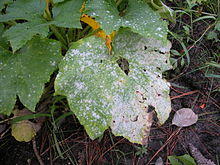| Erysiphales | |
|---|---|
 | |
| Powdery mildew | |
| Scientific classification | |
| Kingdom: | Fungi |
| Division: | Ascomycota |
| Class: | Leotiomycetes |
| Order: | Erysiphales H.Gwynne-Vaughan, 1922 |
| Family: | Erysiphaceae Tul. & C.Tul., 1861 |
| Genera[1] | |
| |
Erysiphales are an order of ascomycete fungi. The order contains one family, Erysiphaceae. Many of them cause plant diseases called powdery mildew.
Systematics
The order contains one family (Erysiphaceae), 28 genera and approximately 100 species. Many imperfect fungi (fungi whose sexual reproduction is unknown) belong here, especially the genus Oidium. Recent molecular data have revealed the existence of six main evolutionary lineages. Clade 1 consists of Erysiphe, Microsphaera, and Uncinula, all of which have an Oidium subgenus Pseudoidium mitosporic state. Clade 2 consists of Erysiphe galeopsidis and Erysiphe cumminsiana (anamorphs in Oidium subgenus Striatoidium). Clade 3 consists of Erysiphe species with anamorphs in Oidium subgenus Reticuloidium. Clade 4 consists of Leveillula and Phyllactinia, which have Oidiopsis and Ovulariopsis mitosporic states, respectively. Clade 5 consists of Sphaerotheca, Podosphaera, and Cystotheca, which have Oidium subgenera Fibroidium and Setoidium mitosporic states. Clade 6 consists of Blumeria graminis, which has an Oidium subgenus Oidium mitosporic state. Several morphological characters have been analysed and found not to conflict with the molecular data.
Characteristics
- Erysiphales have superficial mycelium which extracts nourishment from the host plant through specialized hyphae that penetrate the epidermal cells of the host by means of absorbing organs called haustoria.
- The teleomorphs are usually more distinctive and diverse than the anamorphs. Whether the asci are bitunicate or unitunicate (i.e. consisting of one or two layers), is as yet a matter of discussion.
- The cleistothecia have the asci arranged in a hymenial layer, resembling perithecia.
The cleistothecia ( chasmothecia ) are minute, usually not much more than 0.1 mm in diameter. From the outer wall of the cleistothecium specialised hyphae (appendages) grow out. The number of asci per ascoma varies, and is important in discriminating between genera.
- Erysiphales are notable for intricate appendages which follow fractal geometry within Fibonacci numbers and can be useful for species identification.
Life cycle
The infection of the host plant begins with the sexual ascospores, or the asexual conidia germinating on the surface of the plants leaf or stem, resulting in septate mycelium of uninucleate cells. In most powdery mildews only the epidermal cells are attacked. The external mycelium gives rise to short, erect conidiophores, each of which bearing a single row of barrel-shaped spores, the youngest being at the base (the affected parts become thus covered with a forest of conidiophores assuming a white powdery appearance). The ripe spores become detached and are readily dispersed by the wind, causing fresh infection. In autumn the sexual cleistothecia are produced. The cleistothecia represent the resting (hibernating) stage of the pathogen. The ascospores remain dormant all winter to germinate in spring. When the asci expand they rupture the chasmothecia wall, throwing the ascospores into the air.
Ecology
Erysiphales are obligate parasites on leaves and fruits of higher plants, causing diseases called powdery mildews. Most attempts to grow them in culture have failed.
Erysiphales have a very cosmopolitan distribution and have developed fungicide resistance just as widely.[2] Total loss of function has resulted in some cases.[2] Integrated pest management, use of multi-mode of action fungicides, and decreased frequency of spraying are needed to slow the progress of resistance.[2]
Genera
- Arthrocladiella
- Blumeria
- Brasiliomyces
- Bulbomicrosphaera
- Bulbouncinula
- Caespitotheca
- Cystotheca
- Erysiphe (Oidium)
- Golovinomyces
- Leveillula (Oidiopsis)
- Medusosphaera
- Microsphaera
- Neoerysiphe
- Oidium
- Phyllactinia (Ovulariopsis)
- Pleochaeta
- Podosphaera
- Sawadaea
- Setoerysiphe
- Sphaerotheca
- Typhulochaeta
- Uncinula
- Uncinuliella
References
- "4b: Ascomycetes: − Taphrinales to Dothideales §(13) Order Erysiphales Class Leotiomycetes". The Fifth Kingdom.
- Saenz, Gregory S.; Taylor, John W. (1999). "Phylogeny of the Erysiphales (powdery mildews) inferred from internal transcribed spacer ribosomal DNA sequences". Canadian Journal of Botany. 77 (1): 150–168. doi:10.1139/b98-235.
- A University of Winnipeg page on Erysiphales [1]
- Key to common genera (4 megabyte file) [2]
- Alexopolous, C.J.; Mims, Charles W.; Blackwell, M. (2004). Introductory Mycology (4th ed.). Wiley. ISBN 0-471-52229-5.
- ^ "Erysiphaceae" (HTML). NCBI taxonomy. Bethesda, MD: National Center for Biotechnology Information. Retrieved 29 December 2019.
- ^ a b c Vielba-Fernández, Alejandra; Polonio, Álvaro; Ruiz-Jiménez, Laura; de Vicente, Antonio; Pérez-García, Alejandro; Fernández-Ortuño, Dolores (2020-09-17). "Fungicide Resistance in Powdery Mildew Fungi". Microorganisms. MDPI AG. 8 (9): 1431. doi:10.3390/microorganisms8091431. ISSN 2076-2607. PMC 7564317. PMID 32957583. S2CID 221842640.